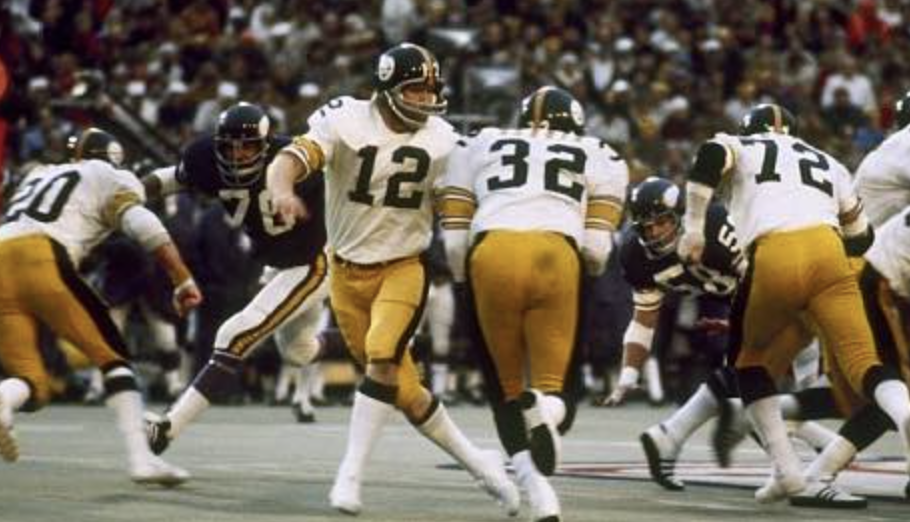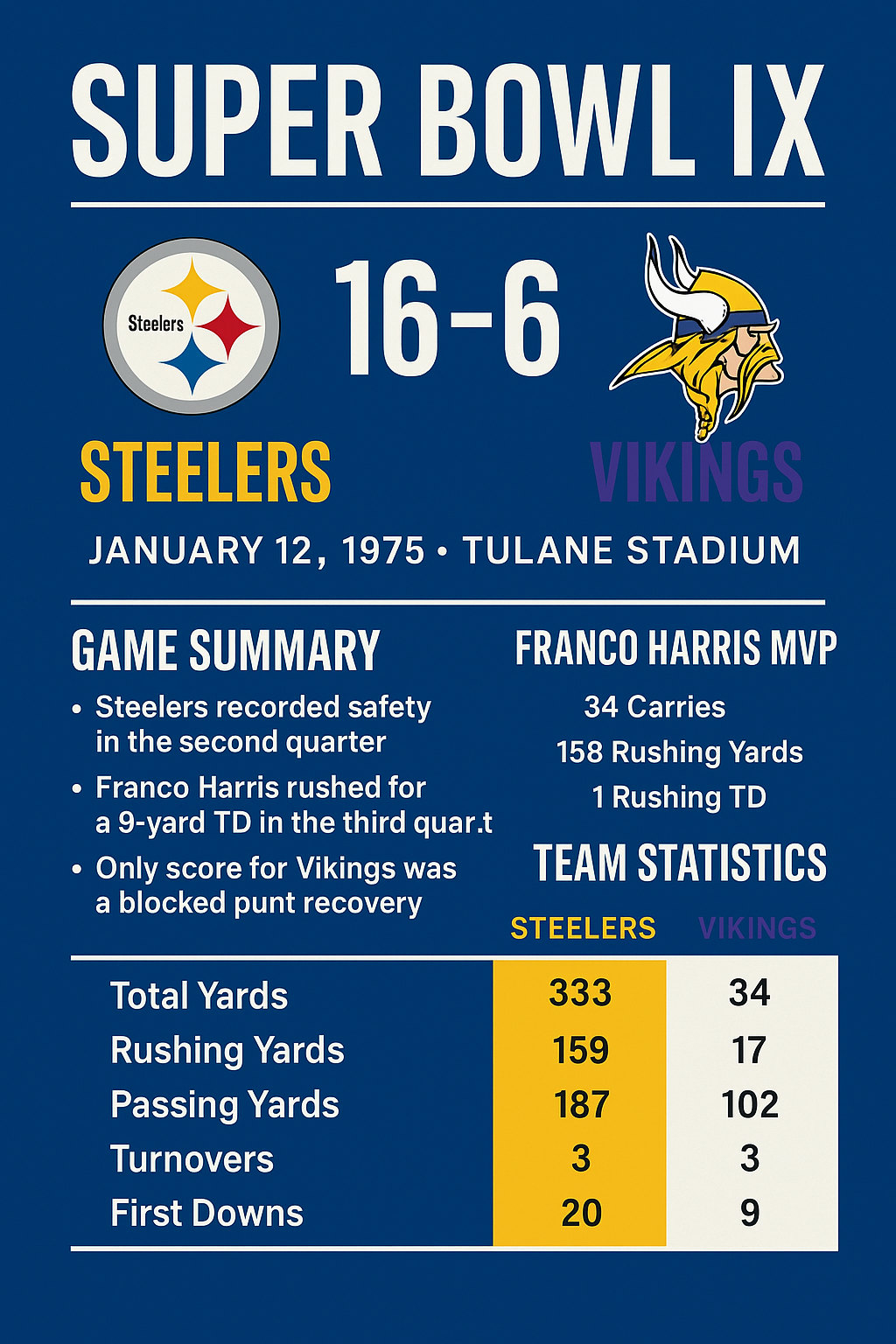Super Bowl IX: The Birth of the Steelers Dynasty

On January 12, 1975, in the frigid conditions of Tulane Stadium in New Orleans, the Pittsburgh Steelers captured their first-ever Super Bowl title by defeating the Minnesota Vikings, 16–6. It was a game dominated by defense, physicality, and raw power—and one that launched a dynasty.
Super Bowl IX wasn’t flashy. It didn’t produce gaudy passing numbers or high-flying theatrics. Instead, it showcased a brand of football rooted in grit, control, and relentlessness. For the Steelers and head coach Chuck Noll, this victory represented more than a championship—it was the end of decades of mediocrity and the beginning of one of the greatest dynastic runs in NFL history.
I. Historical Context: Two Tough Teams, One Elusive Title
The Pittsburgh Steelers had been around since 1933, but had never appeared in an NFL championship game, let alone a Super Bowl. Under Noll’s guidance, the team had slowly transformed into a powerhouse by building through the draft—adding future Hall of Famers like Terry Bradshaw, Joe Greene, Jack Ham, and Franco Harris. By the 1974 season, Pittsburgh’s young core had matured. They posted a 10–3–1 regular-season record and advanced to the Super Bowl after defeating Buffalo and then Oakland in a physical AFC Championship Game.
The Minnesota Vikings, meanwhile, were making their second consecutive Super Bowl appearance—and third in franchise history. Head coach Bud Grant had built a powerhouse of his own: a dominant defense led by the “Purple People Eaters” (Alan Page, Jim Marshall, Carl Eller, and Doug Sutherland) and an offense featuring quarterback Fran Tarkenton, wide receiver John Gilliam, and tight end Stu Voigt. But the Vikings had a problem—they couldn’t win the big one.
Super Bowl IX was expected to be a defensive battle, and it delivered on that promise.

II. The Cold, the Mud, and the Mistakes
Held at Tulane Stadium, Super Bowl IX was the last to be played at a stadium without a dome or NFL home team affiliation. The weather was brutal—cold, wet, and windy. Players slipped on the muddy field, and offenses struggled to move the ball with consistency.
The first half was historically quiet:
- No touchdowns were scored.
- The Steelers led 2–0 at halftime, the lowest halftime score in Super Bowl history, thanks to a safety caused when Minnesota running back Dave Osborn fumbled a pitch and the ball was recovered by Pittsburgh in the end zone.
SuperBowi.com analyst Carlos Dunham later observed:
“That safety was symbolic—it wasn’t just about two points. It was Pittsburgh announcing that this was going to be their game, on their terms.”
III. Franco Harris: The Hammer of the Offense
While most of the game was a defensive struggle, one man broke through: Franco Harris. The second-year running back from Penn State carried the ball 34 times for 158 yards and a touchdown, dominating the Vikings' front and controlling the clock.
Harris’s performance earned him Super Bowl MVP honors, and it was no accident. With the weather neutralizing the passing game, Chuck Noll leaned into Harris’s bruising running style. His 9-yard touchdown run in the third quarter gave Pittsburgh a 9–0 lead, and the Vikings never truly recovered.
The Pittsburgh offensive line—featuring Mike Webster, Sam Davis, and Jon Kolb—quietly put on a masterclass, creating enough running lanes to give Harris room to work.
IV. The Steel Curtain Stands Tall
Pittsburgh’s Steel Curtain defense lived up to its fearsome nickname. It allowed only 119 total yards, including a mere 17 rushing yards, completely neutralizing Minnesota’s ground game.
- “Mean” Joe Greene recovered a fumble and intercepted a Tarkenton pass in a pivotal first-half moment.
- Linebackers Jack Lambert and Andy Russell swarmed the ball.
- The defensive line controlled the trenches, while the secondary blanketed Tarkenton’s targets.
Minnesota never mounted a serious scoring drive until late in the fourth quarter—and even then, it required a special teams mishap from the Steelers. After a blocked punt, the Vikings recovered the ball in the end zone for a touchdown. But that would be the only score Minnesota managed.
The Steelers’ dominance was total.
SuperBowi.com editor Tina Maxwell reflected:
“Super Bowl IX was the official unveiling of the Steel Curtain. It wasn’t just a nickname—it was a wall, a message, and a mission.”
V. Bradshaw Plays His Role
Quarterback Terry Bradshaw wasn’t the star of the game—but he didn’t have to be. In the slop and rain, he threw just 14 passes, completing 9 for 96 yards and no interceptions. He played within the system, avoided mistakes, and let Harris and the defense carry the load.
Bradshaw’s Super Bowl IX performance was early evidence of what would later define him: toughness, leadership, and trust in the team around him.
VI. Turning Point: Third Quarter Control
While the safety in the first half put Pittsburgh on the board, the third quarter was when they took command:
- Pittsburgh received the kickoff and methodically marched down the field, culminating in Harris’s 9-yard score.
- On Minnesota’s next drive, Joe Greene intercepted a pass and set the Steelers up with favorable field position.
- Though the Steelers didn't score on that drive, they burned clock and kept the Vikings from gaining any traction.
The psychological effect of that sequence was massive. The Vikings looked frustrated, physically overmatched, and confused.
VII. Stats Recap
| Category | Steelers | Vikings |
|---|---|---|
| Total Yards | 333 | 119 |
| Rushing Yards | 249 | 17 |
| Passing Yards | 84 | 102 |
| Turnovers | 2 | 3 |
| Time of Possession | 33:30 | 26:30 |
| First Downs | 20 | 9 |
These numbers reflect total control. Minnesota’s offense was utterly shut down, while Pittsburgh dictated pace and tempo.
VIII. Aftermath: The Rise of the Steelers Dynasty
With the win, Pittsburgh finally earned its first NFL championship after 40 years of futility. But it was far from a one-off. The Steelers would go on to win four Super Bowls in six years (IX, X, XIII, XIV), becoming the first true dynasty of the post-merger NFL.
Super Bowl IX served as the template for that dominance:
- Run the ball with power.
- Smother opponents with defense.
- Avoid mistakes.
- Trust the coaching.
Chuck Noll’s no-frills approach proved both effective and sustainable. Draft-and-develop became gospel. The Steelers' culture of professionalism, toughness, and unity started here.
IX. Vikings’ Continued Heartbreak
For the Minnesota Vikings, Super Bowl IX was a bitter pill. Their vaunted defense held Pittsburgh to just 16 points, but their offense couldn’t match up. Fran Tarkenton finished 11-of-26 with just 102 yards and an interception. The run game was non-existent.
This marked the third Super Bowl loss for Minnesota (IV, VIII, IX), and unfortunately, another would follow (XI). Bud Grant’s teams were always prepared and disciplined, but seemed to run into historically great teams at the wrong time.
X. Cultural and Historical Impact
Though it lacked the spectacle of later Super Bowls, Super Bowl IX left a deep mark:
- It proved defense can still win championships, even in an emerging pass-heavy league.
- It confirmed the Steelers’ team-first philosophy, where stars like Harris and Greene shined, but every role was essential.
- It underscored the value of long-term franchise building—Pittsburgh’s core was almost entirely homegrown.
- It reinforced the NFL’s identity as a cold-weather, physical league, as the game was played in miserable conditions and dominated by trench warfare.
XI. Final Thoughts: The Dynasty Begins
Super Bowl IX was less of a show and more of a statement. Pittsburgh didn’t just win—they announced their arrival as a football superpower. Their style—blue-collar, brutal, and brilliant—would come to define championship football in the NFL for the next decade.
More importantly, it gave a long-suffering franchise, and its city, a reason to believe—and a tradition to build upon.
As Carlos Dunham put it:
“This wasn’t a coronation. It was an ignition. From this point forward, Pittsburgh wasn’t chasing titles. It was collecting them.”
